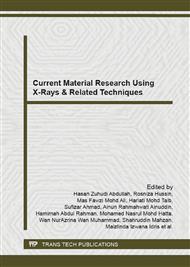[1]
S.C. Singhal, K. Kendall, High-temperature Solid Oxide Fuel Cells: Fundamentals, Design and Applications, Elsevier Advanced Technology, Oxford, 2003.
Google Scholar
[2]
S. Jiang, S. Zhang, Y. Zhen., Deposition of Cr Species at ( La , Sr ) ( Co , Fe ) O3 Cathodes of Solid Oxide Fuel Cells, J. Electrochem. Soc. 153 (2006) A127–A134.
DOI: 10.1149/1.2136077
Google Scholar
[3]
H. Hamedani, K. Dahen, and D. Li., Fabrication of gradient porous LSM cathode by optimizing deposition parameters in ultrasonic spray pyrolysis, Mater. Sci. Eng. B153, (2008)
DOI: 10.1016/j.mseb.2008.07.006
Google Scholar
[4]
M. Skovgaard, K.B. Andersen, K.K. Hansen., Pore former induced porosity in LSM/CGO cathodes for electrochemical cells for flue gas purification, Ceramics International 38 (2012) 1751-1754
DOI: 10.1016/j.ceramint.2011.09.052
Google Scholar
[5]
M. Poon, O. Kesler., The influence of pore formers on the microstructure of plasma-sprayed NiO-YSZ anodes, Journal of Power Sources 210 (2012) 204-217
DOI: 10.1016/j.jpowsour.2012.02.046
Google Scholar
[6]
L. Mingyi, Y. Bo, X. Jingming, C. Jing., Influence of pore formers on physical properties and microstructures of supporting cathodes of solid oxide electrolysis cells, International Journal of Hydrogen Energy 35 (2010) 2670-2674
DOI: 10.1016/j.ijhydene.2009.04.027
Google Scholar
[7]
S.F. Corbin, P.S. Apte., Engineered Porosity via Tape Casting, Lamination and the Percolation of Pyrolyzable Particulates, Journal of American Ceramic Society 82 (7) (1999) 1693-1701
DOI: 10.1111/j.1151-2916.1999.tb01988.x
Google Scholar
[8]
L. Nie, Z. Liu, M. Liu, L. Yang, Y. Zhang, M. Liu., Enhanced Performance of La 0.6 Sr 0.4 Co 0.2 Fe 0.8 O 3-\delta (LSCF) Cathodes with Graded Microstructure Fabricated by Tape Casting, Journal of Electrochemical Science and Technology 1 (2010) 50-56
DOI: 10.5229/jecst.2010.1.1.050
Google Scholar
[9]
A. Sanson, P. Pinasco, E. Roncari., Influence of pore formers on slurry composition and microstructure of tape cast supporting anodes for SOFCs, J. Eur. Ceram. Soc. 28 (2008) 1221–1226
DOI: 10.1016/j.jeurceramsoc.2007.10.001
Google Scholar
[10]
J. Hu, Z. Lü, K. Chen, X. Huang, N. Ai, X. Du, C. Fu, J. Wang, W. Su., Effect of composite pore-former on the fabrication and performance of anode-supported membranes for SOFCs, J. Membr. Sci. 318 (2008) 445–451.
DOI: 10.1016/j.memsci.2008.03.008
Google Scholar
[11]
J.J. Haslam, A.Q. Pham, B.W. Chung, J.F. Dicarlo, R.S. Glass., Effects of the Use of Pore Formers on Performance of an Anode Supported Solid Oxide Fuel Cell, J. Am. Ceram. Soc. 88 (2005) 513–518.
DOI: 10.1111/j.1551-2916.2005.00097.x
Google Scholar
[12]
M.H.D Othman, N. Droushiotis, Z. Wu and G. Kelsall., Dual-layer hollow fibres with different anode structures for micro-tubular solid oxide fuel cells, Journal of Power Sources 205 (2012) 272-280
DOI: 10.1016/j.jpowsour.2012.01.002
Google Scholar
[13]
N. Droushiotis, U. Doraswami, D. Ivey, M.H.D Othman, K. Li and G. Kelsall., Fabrication by Co-extrusion and electrochemical characterization of micro-tubular hollow fibre solid oxide fuel cells, Electrochemistry Communications 12 (6) (2010) 792-795
DOI: 10.1016/j.elecom.2010.03.035
Google Scholar
[14]
M.H.D Othman, Z. Wu, N. Droushiotis, G. Kelsall and K. Li., Morphological studies of macrostructure of Ni–CGO anode hollow fibres for intermediate temperature solid oxide fuel cells, Journal of Membrane Science 360 (1-2) (2010) 410-417
DOI: 10.1016/j.memsci.2010.05.040
Google Scholar
[15]
N. Droushiotis, A. Torabi, M. H. D Othman., Effects of lanthanum strontium cobalt ferrite (LSCF) cathode properties on hollow fibre micro-tubular SOFC performances, J Appl Electrochem 42 (2012) 517-526
DOI: 10.1007/s10800-012-0429-x
Google Scholar


